Citroen C4 PICASSO 2016 2.G Owner's Manual
Manufacturer: CITROEN, Model Year: 2016, Model line: C4 PICASSO, Model: Citroen C4 PICASSO 2016 2.GPages: 527, PDF Size: 13.72 MB
Page 171 of 527

169
C4-Picasso-II_en_Chap04_conduite_ed01-2016
Switching on
The cruise control is switched on manually,
it requires a vehicle speed of between 18 and
112 mph
(30 and 180 km/h).
An
automatic gearbox must be in position D
or M . Other wise,
the last setting made will be used
w
hen switching on the system.
Switching off the ignition cancels any
p
rogrammed speed setting.
When the cruise control is operating, S
top & Start is automatically
deactivated.
Pause
The dynamic cruise control can be paused
manually b y:
-
a
ction by the driver:
●
o
n button 4,
●
o
n the brake pedal,
●
o
n the electric parking brake control,
●
w
hen changing from D to N with an
automatic
gearbox.
-
o
r automatically, if operation of the ESC
system
is triggered for reasons of safety.
Following
braking of the vehicle
b
ringing it to a complete stop, the
s
ystem holds the vehicle stationary ;
t
he cruise control is paused. The driver
s
hould press the accelerator pedal to
move off, then reactivate the system
by
exceeding 18 mph (30 km/h) and
p
ressing button 2, 3 or 4 .
If
the driver takes no action following
t
his immobilisation, the electric parking
b
rake is applied automatically after a
f
ew
m
inutes.
F
W
ith
the
ignition
on,
turn
the
thumbwheel 1
to the " CRUISE "
position:
cruise
control
m
ode
is
selected,
but
not
started
(grey).
F
V
ehicle
moving,
press
one
of
the
buttons 2
or 3 :
the
current
speed
of
your
vehicle
b
ecomes
the
cruise
speed
setting.
The
cruise
control
is
activated
(green).
By default, the inter-vehicle distance is set at
" Normal "
(2
dashes).
4
Driving
Page 172 of 527
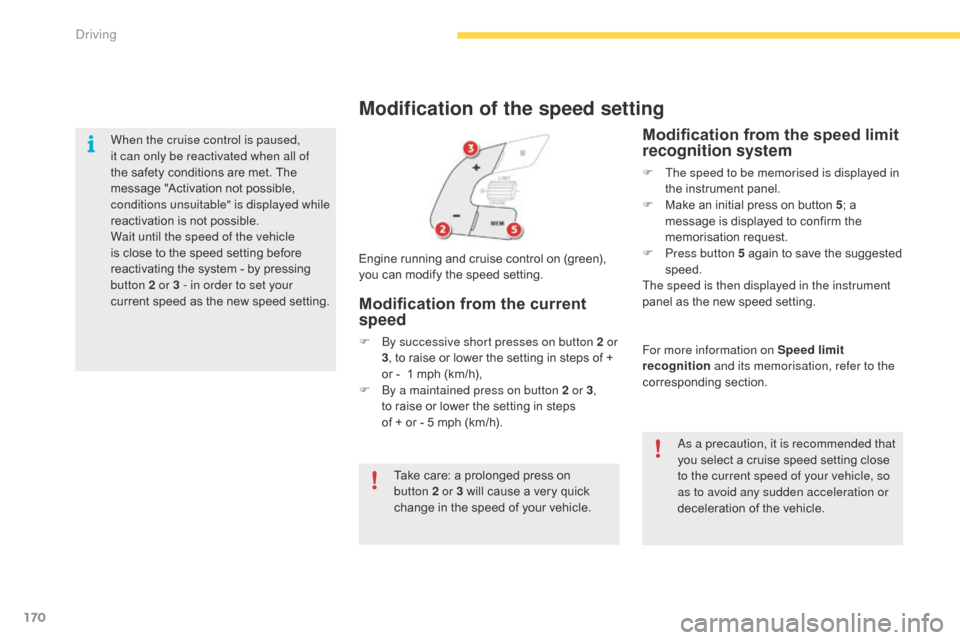
170
C4-Picasso-II_en_Chap04_conduite_ed01-2016
When the cruise control is paused,
it can only be reactivated when all of
the safety conditions are met. The
m
essage "Activation not possible,
c
onditions unsuitable" is displayed while
reactivation
is not possible.
Wait until the speed of the vehicle
is
close to the speed setting before
r
eactivating the system - by pressing
b
utton 2 or 3 - in order to set your
current
speed as the new speed setting.
Modification of the speed setting
Modification from the speed limit
recognition system
F The speed to be memorised is displayed in the instrument panel.
F
M
ake an initial press on button 5;
a
m
essage is displayed to confirm the
m
emorisation
r
equest.
F
P
ress button 5 again to save the suggested
s
peed.
The speed is then displayed in the instrument
panel
as the new speed setting.
As a precaution, it is recommended that
you
select a cruise speed setting close
t
o the current speed of your vehicle, so
as to avoid any sudden acceleration or
deceleration
of the vehicle.
For more information on Speed limit
recognition
and its memorisation, refer to the
corresponding
s
ection.
Engine
running
and
cruise
control
on
(green),
y
ou
can
modify
the
speed
setting.
Modification from the current
speed
F By successive short presses on button 2 or 3,
to raise or lower the setting in steps of +
o
r - 1 mph (km/h),
F
B
y a maintained press on button 2 or 3 ,
to
raise or lower the setting in steps
of
+ or - 5 mph (km/h).
Take
care: a prolonged press on
b
utton 2 or 3 will cause a very quick
c
hange in the speed of your vehicle.
Driving
Page 173 of 527
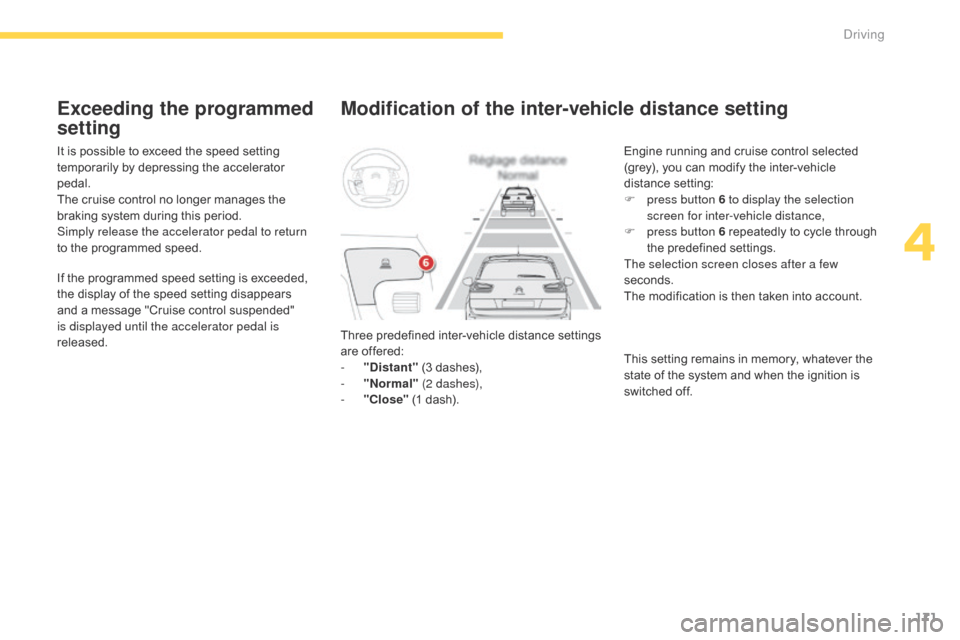
171
C4-Picasso-II_en_Chap04_conduite_ed01-2016
Modification of the inter-vehicle distance setting
Three predefined inter-vehicle distance settings are offered:
-
"
Distant"
(3 dashes),
-
"
Normal" (2 dashes),
-
"
Close"
(1 dash). Engine
running and cruise control selected
(
grey), you can modify the inter-vehicle
d
istance
s
etting:
F
p
ress button 6 to display the selection
screen for inter-vehicle distance,
F
p
ress button 6 repeatedly to cycle through
t
he predefined settings.
The selection screen closes after a few
seconds.
The modification is then taken into account.
This setting remains in memory, whatever the
s
tate of the system and when the ignition is
s
witched off.
It
is
possible
to
exceed
the
speed
setting
t
emporarily
by
depressing
the
accelerator
ped
al.
The
cruise
control
no
longer
manages
the
b
raking
system
during
this
period.
Simply release the accelerator pedal to return
to
the
programmed
speed.
If
the
programmed
speed
setting
is
exceeded,
t
he
display
of
the
speed
setting
disappears
a
nd
a
message
"Cruise
control
suspended"
i
s displayed until the accelerator pedal is
released.
Exceeding the programmed
setting
4
Driving
Page 174 of 527
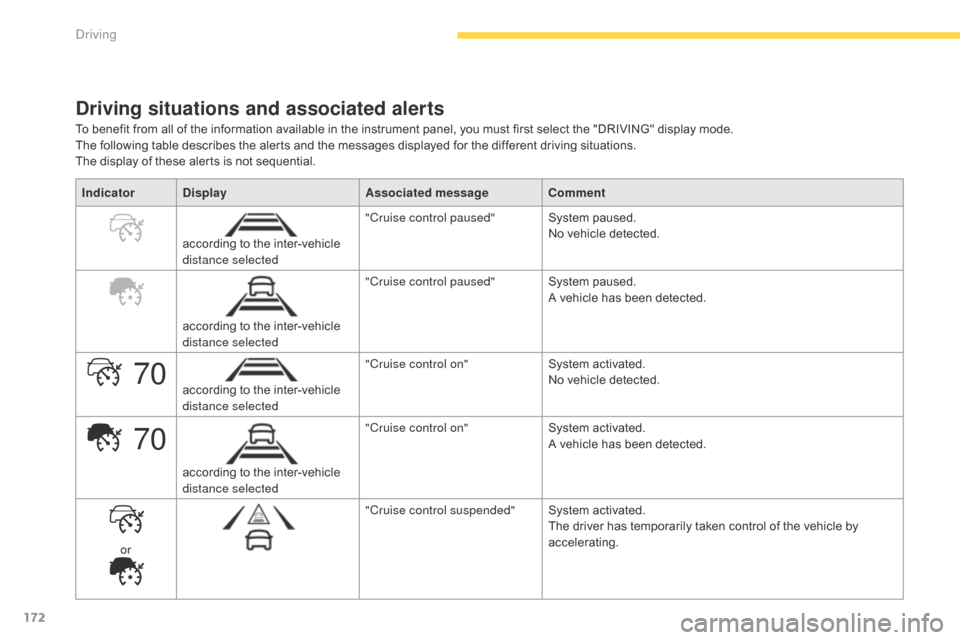
172
70
70
C4-Picasso-II_en_Chap04_conduite_ed01-2016
Driving situations and associated alerts
To benefit from all of the information available in the instrument panel, you must first select the "DRIVING" display mode.
T he following table describes the alerts and the messages displayed for the different driving situations.
The
display of these alerts is not sequential.
Indicator Display Associated messageComment
according
to the inter-vehicle
d
istance selected "Cruise control paused"
System
paused.
No
vehicle detected.
according
to the inter-vehicle
d
istance selected "Cruise control paused"
System
paused.
A
vehicle has been detected.
according
to the inter-vehicle
d
istance selected "Cruise control on"
System
a
ctivated.
No
vehicle detected.
according
to the inter-vehicle
d
istance selected "Cruise control on"
System
a
ctivated.
A
vehicle has been detected.
or "Cruise control suspended"
System
a
ctivated.
The
driver has temporarily taken control of the vehicle by
a
ccelerating.
Driving
Page 175 of 527
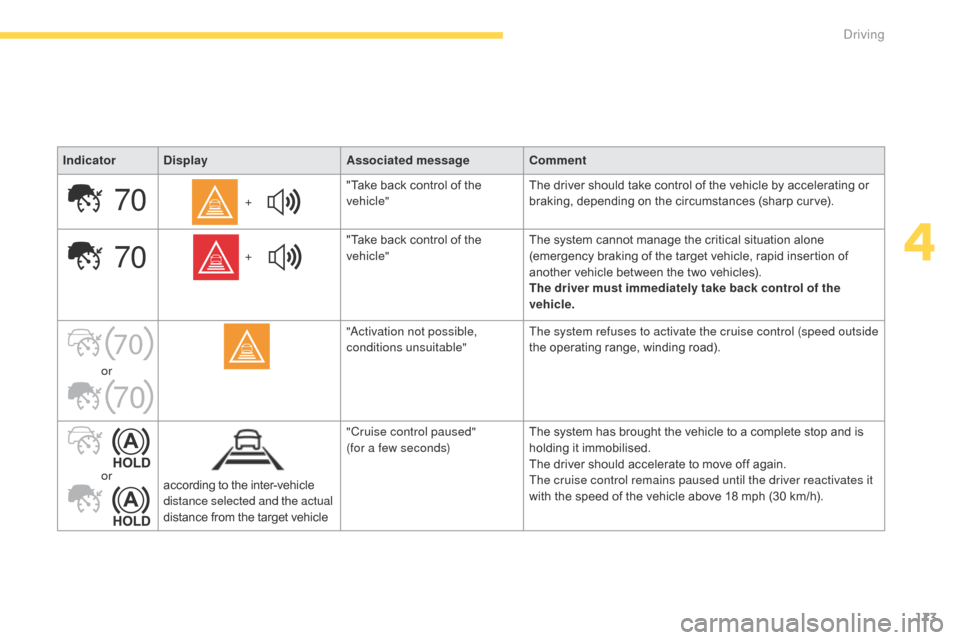
173
70
70
70
70
C4-Picasso-II_en_Chap04_conduite_ed01-2016
IndicatorDisplay Associated messageComment
+ "Take
back control of the
v
ehicle"The
driver should take control of the vehicle by accelerating or
b
raking, depending on the circumstances (sharp curve).
+ "Take
back control of the
v
ehicle"The
system cannot manage the critical situation alone
(
emergency braking of the target vehicle, rapid insertion of
a
nother vehicle between the two vehicles).
The driver must immediately take back control of the
vehicle.
or "Activation not possible,
conditions unsuitable"
The system refuses to activate the cruise control (speed outside
the
operating range, winding road).
or according
to the inter-vehicle
d
istance selected and the actual
distance
from the target vehicle"Cruise control paused"
(for a few seconds)
The
system has brought the vehicle to a complete stop and is
h
olding it immobilised.
The
driver should accelerate to move off again.
The cruise control remains paused until the driver reactivates it
with
the speed of the vehicle above 18 mph (30 km/h).
4
Driving
Page 176 of 527
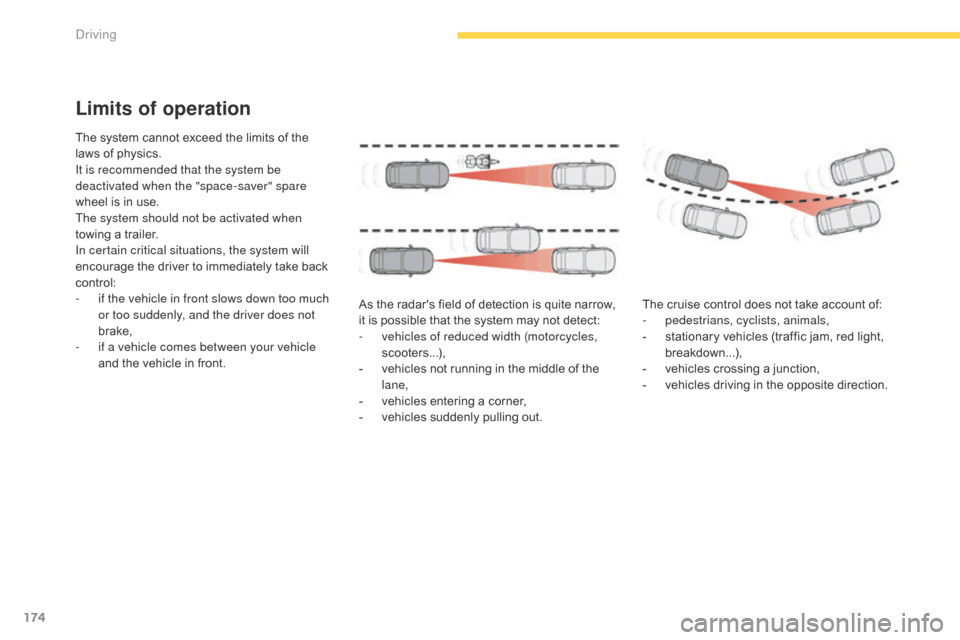
174
C4-Picasso-II_en_Chap04_conduite_ed01-2016
Limits of operation
The system cannot exceed the limits of the laws of physics.
It is recommended that the system be
deactivated when the "space-saver" spare
wheel
is in use.
The system should not be activated when
towing
a trailer.
In certain critical situations, the system will
encourage
the driver to immediately take back
c
ontrol:
-
i
f the vehicle in front slows down too much
or too suddenly, and the driver does not
brake,
-
i
f a vehicle comes between your vehicle
and
the vehicle in front. As
the radar's field of detection is quite narrow,
i
t is possible that the system may not detect:
-
v
ehicles of reduced width (motorcycles,
scooters...),
-
v
ehicles not running in the middle of the
lan
e,
-
v
ehicles entering a corner,
-
v
ehicles suddenly pulling out.The
cruise control does not take account of:
-
p
edestrians, cyclists, animals,
-
s
tationary vehicles (traffic jam, red light,
b
reakdown...),
-
v
ehicles crossing a junction,
-
v
ehicles driving in the opposite direction.
Driving
Page 177 of 527
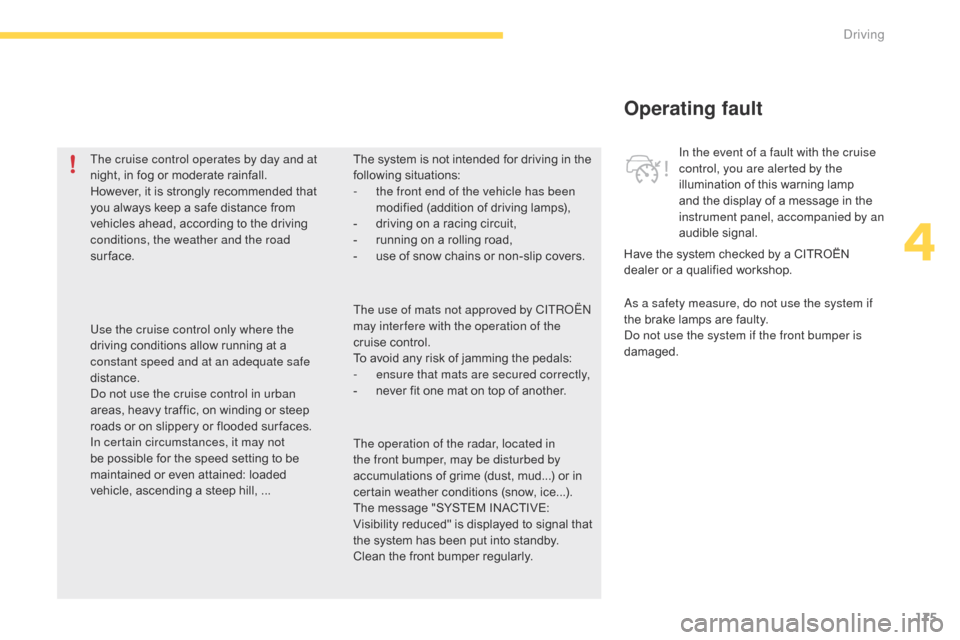
175
C4-Picasso-II_en_Chap04_conduite_ed01-2016
Operating fault
As a safety measure, do not use the system if
the brake lamps are faulty.
Do not use the system if the front bumper is
damaged. In the event of a fault with the cruise
control, you are alerted by the
illumination
of this warning lamp
a
nd the display of a message in the
in
strument panel, accompanied by an
audible
s
ignal.
The cruise control operates by day and at
night,
in
fog
or
moderate
rainfall.
However,
it
is
strongly
recommended
that
y
ou
always
keep
a
safe
distance
from
v
ehicles
ahead,
according
to
the
driving
c
onditions, the weather and the road
sur face.
Use the cruise control only where the
driving
conditions
allow
running
at
a
c
onstant speed and at an adequate safe
distance.
Do not use the cruise control in urban
areas,
heavy
traffic,
on
winding
or
steep
r
oads
or
on
slippery
or
flooded
sur faces.
In certain circumstances, it may not
be
possible
for
the
speed
setting
to
be
m
aintained
or
even
attained:
loaded
v
ehicle,
ascending
a
steep
hill,
... The
system
is
not
intended
for
driving
in
the
fo
llowing
s
ituations:
-
t
he front end of the vehicle has been
modified
(addition
of
driving
lamps),
-
d
riving
on
a
racing
circuit,
-
r
unning
on
a
rolling
road,
-
u
se
of
snow
chains
or
non-slip
covers.
Have the system checked by a CITROËN
d
ealer or a qualified workshop.
The operation of the radar, located in
the front bumper, may be disturbed by
accumulations
of
grime
(dust,
mud...)
or
in
c
ertain
weather
conditions
(snow,
ice...).
The
message
"SYSTEM
INACTIVE:
V
isibility
reduced"
is
displayed
to
signal
that
t
he
system
has
been
put
into
standby.
Clean
the
front
bumper
regularly.
The use of mats not approved by CITROËN
may inter fere with the operation of the
cruise
control.
To
avoid
any
risk
of
jamming
the
pedals:
-
e
nsure that mats are secured correctly,
-
n
ever
fit
one
mat
on
top
of
another.
4
Driving
Page 178 of 527
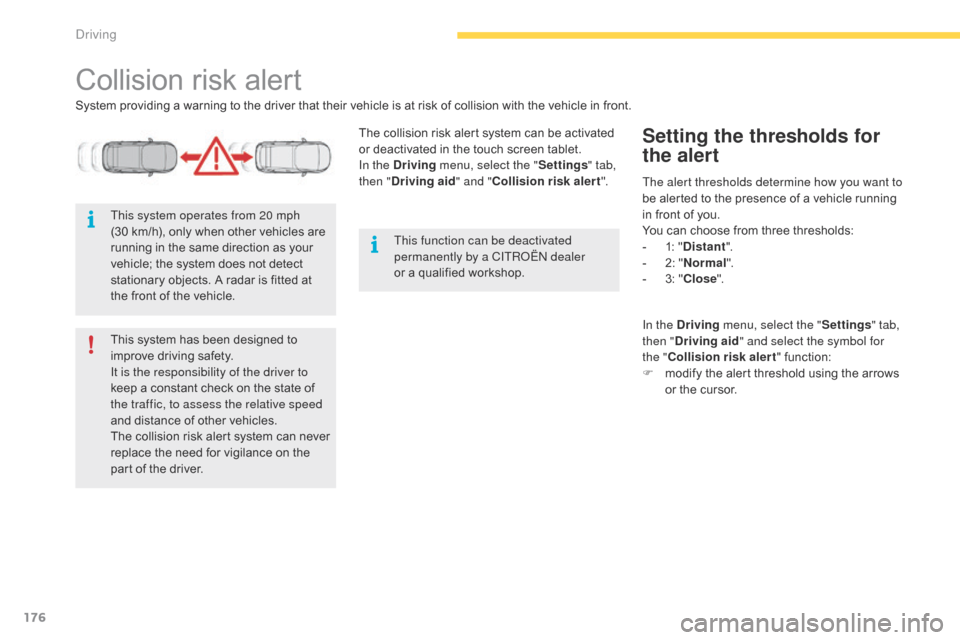
176
C4-Picasso-II_en_Chap04_conduite_ed01-2016
Collision risk alert
System providing a warning to the driver that their vehicle is at risk of collision with the vehicle in front.
T he collision risk alert system can be activated
o
r deactivated in the touch screen tablet.
In the Driving menu, select the " Settings" tab,
then " Driving aid " and "Collision risk alert ".
This
system has been designed to
i
mprove driving safety.
It is the responsibility of the driver to
keep
a constant check on the state of
t
he traffic, to assess the relative speed
and
distance of other vehicles.
The
collision risk alert system can never
r
eplace the need for vigilance on the
p
art of the driver.
This system operates from 20 mph
(30 km/h),
only when other vehicles are
r
unning in the same direction as your
v
ehicle; the system does not detect
s
tationary objects. A radar is fitted at
t
he front of the vehicle. The alert thresholds determine how you want to
be
alerted to the presence of a vehicle running
i
n front of you.
You
can choose from three thresholds:
-
1
: "Distant ".
-
2
: "Normal ".
-
3
: "Close ".
Setting the thresholds for
the alert
This function can be deactivated
permanently by a CITROËN dealer
or
a qualified workshop.
In the Driving menu, select the " Settings" tab,
then " Driving aid " and select the symbol for
the " Collision risk alert "
function:
F
m
odify the alert threshold using the arrows
o
r the cursor.
Driving
Page 179 of 527
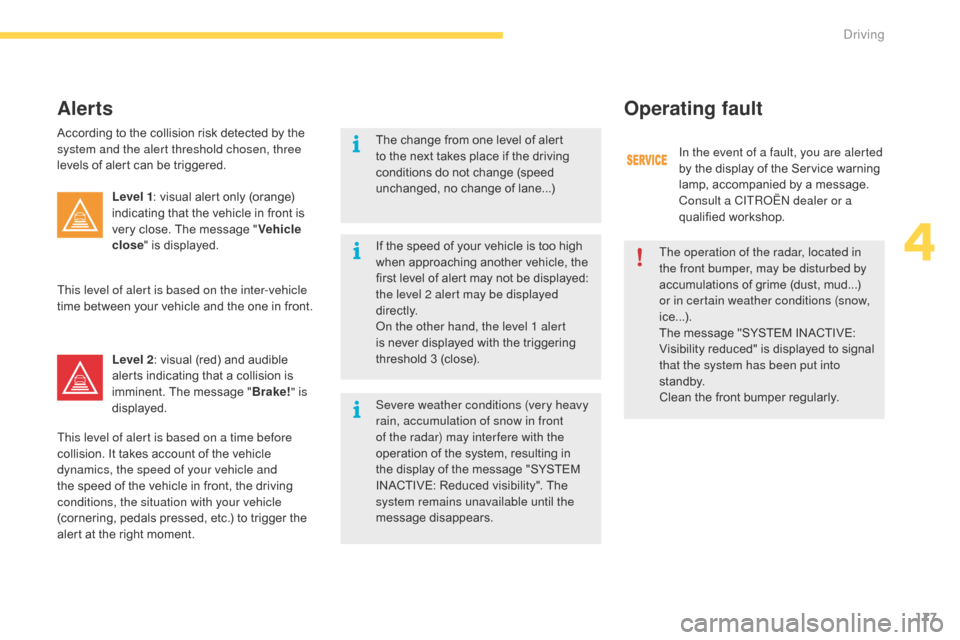
177
C4-Picasso-II_en_Chap04_conduite_ed01-2016
The change from one level of alert to the next takes place if the driving
c
onditions do not change (speed
u
nchanged, no change of lane...)
Severe weather conditions (very heavy
rain, accumulation of snow in front
of the radar) may inter fere with the
operation
of the system, resulting in
t
he display of the message "SYSTEM
I
NACTIVE: Reduced visibility". The
s
ystem remains unavailable until the
message
d
isappears.
If
the speed of your vehicle is too high
w
hen approaching another vehicle, the
f
irst level of alert may not be displayed:
t
he level 2 alert may be displayed
di r e c t l y.
On the other hand, the level 1 alert
is
never displayed with the triggering
t
hreshold 3 (close).
Alerts
According to the collision risk detected by the system and the alert threshold chosen, three
levels
of alert can be triggered.
Level 1 :
visual alert only (orange)
i
ndicating that the vehicle in front is
v
ery close. The message "Vehicle
close "
is displayed.
Level 2 :
visual (red) and audible
a
lerts indicating that a collision is
i
mminent. The message "Brake! " is
displayed.
This level of alert is based on the inter-vehicle
time
between your vehicle and the one in front.
This level of alert is based on a time before
collision.
It takes account of the vehicle
d
ynamics, the speed of your vehicle and
the
speed of the vehicle in front, the driving
c
onditions, the situation with your vehicle
(cornering,
pedals pressed, etc.) to trigger the
a
lert at the right moment.
Operating fault
In the event of a fault, you are alerted
by the display of the Service warning
l
amp, accompanied by a message.
Consult a CITROËN dealer or a
qualified
w
orkshop.
The operation of the radar, located in
the front bumper, may be disturbed by
accumulations
of grime (dust, mud...)
o
r in certain weather conditions (snow,
ice...).
The
message "SYSTEM INACTIVE:
V
isibility reduced" is displayed to signal
t
hat the system has been put into
st a n dby.
Clean
the front bumper regularly.
4
Driving
Page 180 of 527
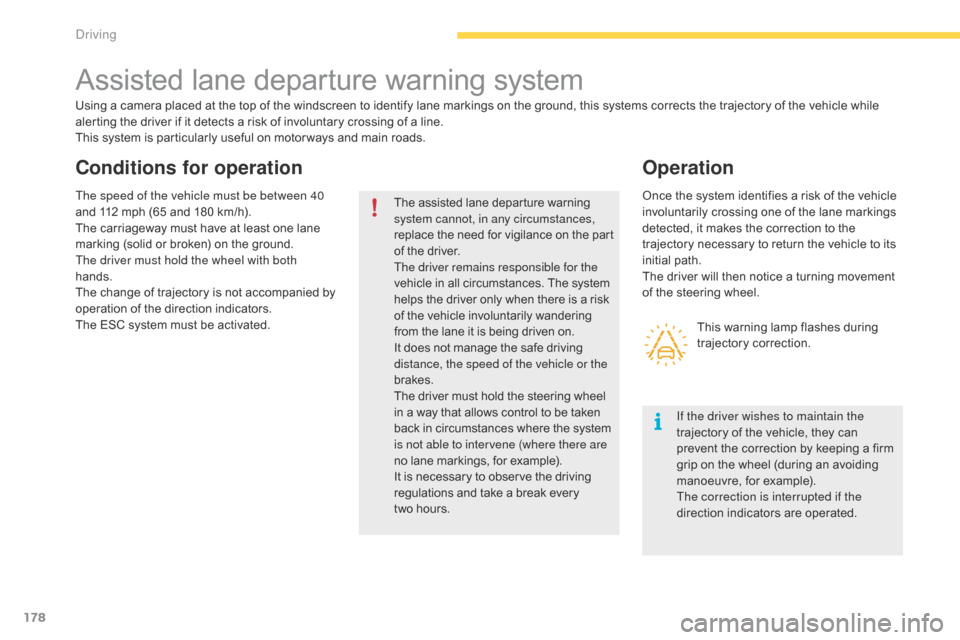
178
C4-Picasso-II_en_Chap04_conduite_ed01-2016
Assisted lane departure warning system
Using a camera placed at the top of the windscreen to identify lane markings on the ground, this systems corrects the trajectory of the vehicle while alerting the driver if it detects a risk of involuntary crossing of a line.
This
system is particularly useful on motor ways and main roads.
The
assisted lane departure warning
s
ystem cannot, in any circumstances,
replace
t
he
n
eed
fo
r
v
igilance
o
n
t
he
par
t
o
f the driver.
The driver remains responsible for the
vehicle
in all circumstances. The system
h
elps the driver only when there is a risk
o
f the vehicle involuntarily wandering
f
rom the lane it is being driven on.
I
t does not manage the safe driving
d
istance, the speed of the vehicle or the
brakes.
The
driver must hold the steering wheel
i
n a way that allows control to be taken
b
ack in circumstances where the system
i
s not able to intervene (where there are
no
lane markings, for example).
It
is necessary to observe the driving
r
egulations and take a break every
t
wo hours.
Operation
Conditions for operation
The speed of the vehicle must be between 40
and
112 mph (65 and 180 km/h).
The
carriageway must have at least one lane
m
arking (solid or broken) on the ground.
The driver must hold the wheel with both
hands.
The
change of trajectory is not accompanied by
o
peration of the direction indicators.
The
ESC system must be activated. Once
the system identifies a risk of the vehicle i
nvoluntarily crossing one of the lane markings
d
etected, it makes the correction to the
t
rajectory necessary to return the vehicle to its
in
itial
pa
th.
The
driver will then notice a turning movement
o
f the steering wheel.
This
warning lamp flashes during
t
rajectory
c
orrection.
If the driver wishes to maintain the
trajectory
of the vehicle, they can
p
revent the correction by keeping a firm
g
rip on the wheel (during an avoiding
m
anoeuvre, for example).
The correction is interrupted if the
direction
indicators are operated.
Driving